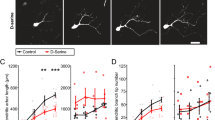Summary
We have investigated the postnatal development of N-methyl-D-aspartate (NMDA) receptors in kitten neocortex by measuring the density of [3H] MK801 binding sites. NMDA receptor density in area 17 markedly increases between postnatal day 7 and 35, and then remains at a high level into adulthood. Similar temporal changes were observed in area 6. A brief period of binocular deprivation did not alter the density of [3H] MK801 binding sites in either brain region. However, dark rearing kittens from birth resulted in a significant decrease after 35 and 120 days in both area 17 and area 6. These results demonstrate that the density of NMDA receptors does not effectively predict the capacity for visual cortical plasticity in kitten neocortex. In addition, these results show that dark rearing produces significant effects in areas of the kitten neocortex not normally associated with visual function.
Similar content being viewed by others
References
Artola A, Singer W (1987) Long-term potentiation and NMDA receptors in rat visual cortex. Nature 330:649–652
Bear MF, Colman H (1990) Binocular competition in the control of geniculate cell size depends upon visual cortical NMDA receptor activation. Proc Natl Acad Sci USA 87:9246–9249
Bear MF, Cooper LN, Ebner FF (1987) A physiological basis for a theory of synapse modification. Science 237:42–48
Bear MF, Cooper LN (1990) Molecular mechanisms of experience-dependent synaptic modification in the visual cortex: interaction between theory and experiment. In: Gluck MA, Rumelhardt DE (eds) Neuroscience and connectionist theory. Lawrence Erlbaum, Hillsboro NJ
Bear MF, Kleinschmidt A, Gu Q, Singer W (1990) Disruption of experience-dependent synaptic modifications in striate cortex by infusion of an NMDA receptor antagonist. J Neurosci 10:909–925
Bode-Greuel KM, Singer, W (1989) The development of N-methyl-D-aspartate receptors in cat visual cortex. Dev Brain Res 46:197–204
Cline HT, Debski HT, Constantine-Paton M (1987) NMDA receptor antagonist desegregates eye-specific stripes. Proc Natl Acad Sci USA 84:4342–4345
Cline HT, Constantine-Paton M (1990) NMDA receptor agonist and antagonists alter retinal ganglion cell arbor structure in the developing frog retinotectal projection. J Neurosci 10:1197–1216
Collingridge GL, Kehl SJ, McLennan H (1983) Excitatory amino acids in synaptic transmission in the Schaffer collateral-commissural pathway of the rat hippocampus. J Physiol 334:33–46
Connors BW, Bear MF (1988) Pharmacological modulation of long term potentiation in slices of visual cortex. Neuroscience Abstr 14:298.8
Cynader M (1983) Prolonged sensitivity to monocular deprivation in dark reared cats: Effects of age and visual exposure. Dev Brain Res 8:155–164
Cynader M, Mitchell DE (1980) Prolonged sensitivity to monocular deprivation in dark reared cats. J Neurophysiol 43:1026–1040
Dingledine R (1983) N-methylaspartate activates voltage-dependent calcium conductance in rat hippocampal pyramidal cells. J Physiol 343:385–405
Feldman D, Sherin JE, Press WA, Bear MF (1990) NMDA stimulated calcium uptake by kitten visual cortex in vitro. Exp Brain Res 80:252–259
Foster AC, Wong EHF (1987) The novel anticonvulsant MK801 binds to the activated state of the N-methyl-D-aspartate receptor in rat brain. Br J Pharmacol 91:403–409
Fox K, Sato H, Daw N (1989) The location and function of NMDA receptors in cat and kitten visual cortex. J Neurosci 9:2443–2454
Gu Q, Bear MF, Singer W (1989) Blockade of NMDA-receptors prevents ocularity changes in kitten visual cortex after reversed monocular deprivation. Dev Brain Res 47:281–288
Hubel DH, Wiesel TN (1970) The period of susceptibility to the physiological effects of unilateral eye closure in kittens. J Physiol 206:419–436
Kimura F, Nishigori A, Shirokawa T, Tsumoto T (1989) Long-term potentiation and N-methyl-D-aspartate receptors in the visual cortex of young rats. J Physiol 414:125–144
Kleinschmidt A, Bear MF, Singer W (1987) Blockade of “NMDA” receptors disrupts experience-dependent plasticity of kitten striate cortex. Science 238:355–358
Mayer ML, Westbrook GL (1987) The physiology of excitatory amino acids in the vertebrate central nervous system. Prog Neurobiol 28:197–276
McDermott AB, Mayer ML, Westbrook GL, Smith SJ, Barker JL (1986) NMDA receptor activation increases cytoplasmic calcium concentration in cultured spinal cord neurones. Nature 321:519–522
Miller KD (1990) Correlation-based models of neural development. In: Gluck MA, Rumelhardt DE (eds) Neuroscience and connectionist theory. Lawrence Erlbaum, Hillsboro NJ
Mower GD, Christen WG (1985) Role of visual experience in activating critical period in cat visual cortex. J Neurophysiol 53:572–589
Nowak L, Bregostovski, Ascher P, Herbert A, Prochiantz A (1984) Magnesium gates glutamate-activated channels in mouse central neurones. Nature 307:462–465
Olson CR, Freeman RD (1980) Profile of the sensitive period for monocular deprivation in kittens. Exp Brain Res 39:17–21
Press WA, Bear MF (1990) Effects of disinhibition on LTP induction in slices of visual cortex. Neuroscience Abstr 16:839
Reynolds IJ, Bear MF (1989) NMDA receptor development in the visual cortex of cats. Soc Neurosci Abstr 15:2
Reynolds IJ, Murphy SN, Miller RJ (1987) 3H-labelled MK801 binding to the excitatory amino acid receptor complex from rat brain is enhanced by glycine. Proc Natl Acad Sci (USA) 84:7744–7748
Reynolds IJ, Miller, RJ (1988) Ifenprodil is a novel type of NMDA receptor antagonist: interaction with polyamines. Mol Pharmacol 36:758–765
Reynolds IJ (1990) Arcaine uncovers dual interactions of polyamines with the N-methyl-D-aspartate receptor. J Pharmacol Exp Ther 255:1001–1007
Schmidt JT (1990) Long-term potentiation and activity-dependent retinotopic sharpening in the regenerating retinotectal projection of goldfish: common sensitive period and sensitivity to NMDA blockers. J Neurosci 10:233–246
Scherer WJ, Udin SB (1989) N-methyl-D-aspartate antagonists prevent interaction of binocular maps in Xenopus tectum. J Neurosci 9:3837–3843
Winkler C, Potter A (1914) An anatomical guide to experimental researches on the cats brain. Versluys, Amsterdam
Author information
Authors and Affiliations
Rights and permissions
About this article
Cite this article
Reynolds, I.J., Bear, M.F. Effects of age and visual experience on [3H] MK801 binding to NMDA receptors in the kitten visual cortex. Exp Brain Res 85, 611–615 (1991). https://doi.org/10.1007/BF00231745
Received:
Accepted:
Issue Date:
DOI: https://doi.org/10.1007/BF00231745




